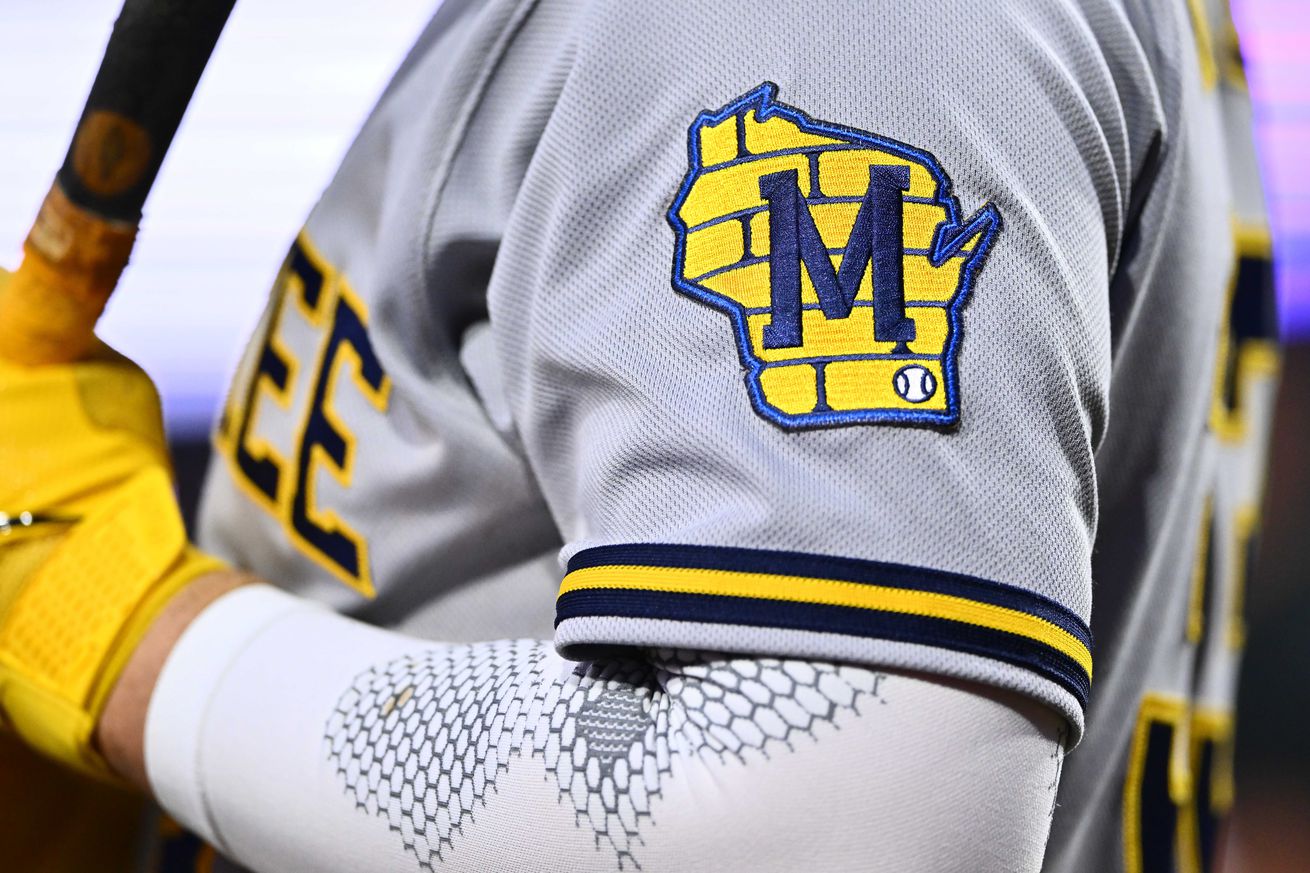
It seems like every year we under-estimate the Brewers talent. Why?
Authors Note: I haven’t really figured out the Brewers secret sauce, but I have uncovered some interesting nuts and I am hoping my fellow squirrels will help direct me on where to look next.
My interest is looking at the Brewers somewhat systemically. Why or how they’ve become consistently good for a period of time. Not so much about why they were good last year. So, I’m not going to delve into their 2024 high OBP rates, or fabulous defense, or getting career years from so many players at one time. Those things ebb and flow, but their success has not in the recent past. Why?
In 2016, the Brewers went 73-89. Since then, in the seven full seasons played they have won the NL Central 4 times (as compared to twice for the Cardinals). Mostly, they have been winning by exceeding expectations, at least Cardinal fan expectations. How do they do it? I picked that 2016 date for two reasons. First, it was their last losing season. Second, well, I will show you.
You’ve seen the following table, at least its format, before. I showed it to you when assessing how the Cardinals do when they succeed and when they do not. Some themes from that article:
- If you want to make the playoffs, 40 WAR is a really good talent target to shoot for.
- Total payroll factor (100 = league average) is not crucial to winning. The Cardinals typically sit around 110% of league average but have down shifted in recent years. They’ve won with low payrolls and lost with high.
- Although payroll heights aren’t crucial, payroll efficiency certainly is. .15 is bad. .20 is OK. Anything .25 or higher is really good. League-wide, not just the Cardinals.
So, I set up the same table with Brewer data. Lots to look at.
I first direct your attention to the Payroll Factor column. Note the Brewers clearly operate a tier below the Cardinals in terms of payroll. They’ve only sniffed league average twice, and it looks like they couldn’t get away from that fast enough.
Next, I will direct your attention to the payroll efficiency column, specifically beginning with the year 2016. If you remember, payroll efficiency is a measure on how many WAR did a team capture with the payroll dollars they spent. The 2023 Mets, spending $300 million-plus and getting 79 wins is the ultimate in poor payroll efficiency.
Somehow, the Brewers changed spots after that dreadful 2016 season and went from ordinary in payroll efficiency to elite and have become the dominant team in the NL Central as a result. Coincidence? I think not.
Let’s take a closer look at the Brewers using the same tools I’ve used with the Cardinals and see what we can discern.
Is it drafting and development?
Starting with drafting, here are the 2000-2024 notable players the Brewers drafted. Overall, they are middle of the road in draft-and-develop (17th). The lag the Cardinals in total WAR acquire by about 100 WAR. They don’t really play in the IFA space. They aren’t horrible, but this isn’t their secret sauce, either.
Overall, they’ve maintained a pace of picking up 1 or 2 notables a year, on average. This is what is necessary to build and sustain a competitive program. They do appear to have a strength in picking pitchers. But again, not clearly a differentiator.
Do they over-perform their talent level?
I’m going to go back to the first chart and gander a bit. One thing I notice is that the WAR accumulations for those recent seasons aren’t astronomically high. Right around 40. Good enough, but indicative of 88-win teams (ish), not the kind of juggernaut that will capture the division 4 out of 7 years. Let’s look and see if they outperform their WAR.
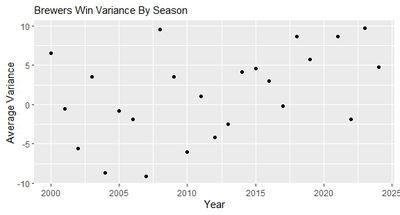
So, other than 2022, the Brewers recently have outperformed their WAR by 5-10 wins. We’ve seen this phenomenon with St. Louis. Put together enough talent to win 88 games (ie. 40 WAR), then watch the team win in the low 90’s in the NL Central. Turns out the Cardinals aren’t the only ones that can do this.
How about their talent acquisition from imports (trades, free agents)?
Maybe the Brewers are just better at roster construction through player import (trades and free agency). Let’s look.
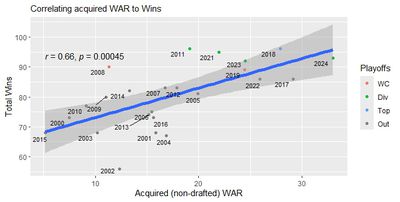
Hmmm. Pretty high correlation there. But more so, take a look at the recent years (ie. since 2016). All in the upper-right quadrant. Suffice to say, they have become superior in acquiring talent from the outside. And doing it very efficiently, payroll wise.
One thing stands out, but it is very hard to graph. The Brewers really only have 1 large contract (Yelich at $26m/yr). Otherwise, they seem pretty good at avoiding large and unproductive contracts. Remember, the larger the contract the easier it is to view as unproductive. Outside of Yelich, their largest contract is $12m, which has value at around 1.5 WAR. By comparison, the Cardinals have 4 large contracts and arguably all 4 are under-productive. I’d say there seems to be a discernible strategy difference here … if you aren’t a star, the Brewers don’t want to pay you any money and would prefer to use a low dollar solution. The Cardinals aren’t nearly as aggressive about filling talent holes with low dollar solutions.
Does offense or pitching + defense drive this?
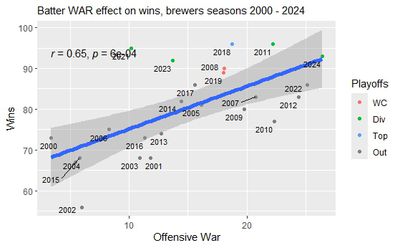
The league wide correlation of offense WAR to Wins is .71. The Brewers fall just below that. 2024 was an outlier year, offensive output wise (almost 30 WAR!). I’m going to bet they had a number of guys that had career years. I’m thinking no way they repeat this, but then again, I don’t want to under-estimate them, yet again. But they do get a lot of their value from the offensive side. Even with Yelich perpetually injured.
One thing I notice about their offense — they really aren’t mix-and-match so much. They move people up and down the line-up and around positions a bit, but they have 7 guys who were regulars (130+ games and most 140+) and Yelich would likely have been another if he hadn’t gotten hurt.
Let’s look at pitching and defense.
First. let’s looking at just pitching. Really, the Brewers pitching has been nothing special over the years, except for 2021. Think of ~18 WAR as the pitching threshold for a good team, and Brewers typically fall on the wrong side of this line.
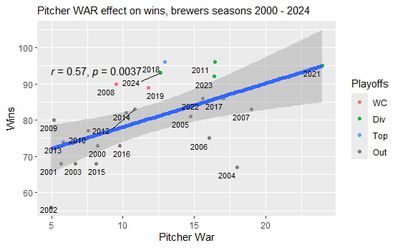
Turns out, the loss of Burnes after 2023 wasn’t as impactful as one would have imagined, because that wasn’t the crux of what they’re doing.
I notice that in contrast to the offense, the pitching is complete mix-and-match. Lots of 1-1.5 WAR guys. The #4 starter made all of 14 starts. Many, many guys got the ball for them. Same story in the bullpen. But one reliever exceeded 60 appearances.
Contrast that with 5 guys in St. Louis with 60+ appearances and 2 more with 50+. Overall, the Cardinals had less relief appearances on the 2024 season, but the Brewers spread it around quite a bit more flexibly. Not sure what to make of this, but I notice the fairly stark contrast. Another stat – 15 Brewer relievers made positive WAR contribution, total of 5.9 WAR. The Cardinals had only 9 positive WAR relievers, total bullpen WAR of 3.9 (granted, over 70 less innings). Most of that 3.9 WAR was one Ryan Helsley. Again, in comparison to the Brewers, somewhat top-heavy.
Now, watch how the WAR values shift a fair bit to the right when I add defense in, well above the ~18 WAR threshold. In the Brewers secret sauce, defense plays a key ingredient. I’d characterize it as … their defense allows them to invest in low cost, low WAR pitchers that play up and accumulate enough WAR to win.
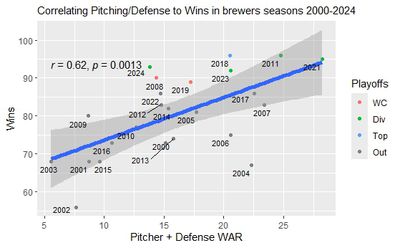
The recipe (at first glance)
So, what I see so far are four ingredients that the Brewers put together:
- Relentless use of low cost, low WAR players.
- Defense to maximize the pitching.
- Tons of offense.
- Mix and match on the pitching side, but not the position player side.
So, I could say their secret sauce might be offense + defense is 80% of their game and they appear quite clever at putting to together a roster that maximizes these features at very low cost.
To contrast that with the Cardinals, who have become a bit top heavy, spending big on stars and mid-range players to middling results.
Going forward
So, at risk of under-estimating the Brewers again, I’m wondering a couple of things.
- How much will they miss Williams? I’m guessing some, but not a huge amount. It will probably be more emotional, in a way not reflected in FIP or WAR. In the way that blown saves can have a disproportionate impact on a team.
- How much will they miss Adames? I think a lot. He was a key contributor both offensively and defensively. And he played a key, up the middle, defensive role.
- That said, they are good. Solid almost everywhere, with the exception of 1b and maybe the starting pitching.
Thoughts? Where should I delve deeper into this analysis?